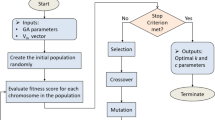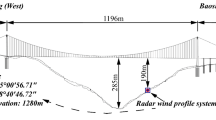Abstract
Wind speed and wind direction are two important factors to describe the wind properties. The statistical probability model of wind speed and wind direction is widely used to characterize the uncertainty of wind field around the structures. Considering the correlation between the wind speed and wind direction, they should be modeled simultaneously, which highlights the importance of using joint probability density function (JPDF) to describe the wind properties. An angular–linear (AL) model is employed to construct the JPDF of wind speed and wind direction based on long-term monitoring data. The finite mixture (FM) Gumbel distribution, which models the wind speed, and the FM von Mises distribution, which models the wind direction, are proposed to formulate the AL model. Expectation–maximization (EM) and genetic algorithm (GA) are adopted to estimate the AL model parameters. For the EM method, the analytical expressions for calculating the AL model parameters are derived. For the GA method, the analytical fitness functions are derived. These derived analytical expressions facilitate the implementation of the EM and GA methods. One-year wind monitoring data collected by structural health monitoring (SHM) system installed on Jiubao Bridge is employed to demonstrate the feasibility of the AL model-based method in evaluating the wind properties. The results show that the AL model formulated by the FM Gumbel distribution and FM Von Mises distribution is effective for establishing JPDF for joint modeling of the wind speed and wind direction. In the AL model, the EM method is more effective for estimating the parameters of the FM von Mises distribution, whereas the GA methods is more powerful for estimating the parameters of the FM Gumbel distribution.













Similar content being viewed by others
References
Ye XW, Jin T, Yun CB (2019) A review on deep learning-based structural health monitoring of civil infrastructures. Smart Struct Syst 24(5):567–586
Tao T, Wang H, Wu T (2016) Comparative study of the wind characteristics of a strong wind event based on stationary and nonstationary models. J Struct Eng 143(5):04016230
Petersen OW, Oiseth O, Lourens EM (2019) The use of inverse methods for response estimation of long-span suspension bridges with uncertain wind loading conditions: practical implementation and results for the Hardanger Bridge. J Civ Struct Health Monit 9(1):21–36
Ye ZL, Li N, Zhang FJ (2019) Wind characteristics and responses of Xihoumen Bridge during typhoons based on field monitoring. J Civ Struct Health Monit 9(1):1–20
Larsen A, Larose GL (2015) Dynamic wind effects on suspension and cable-stayed bridges. J Sound Vib 334:2–28
Ye XW, Yuan L, Xi PS, Liu H (2018) SHM-based probabilistic representation of wind properties: Bayesian inference and model optimization. Smart Struct Syst 21(5):601–609
Saha UK, Thotla S, Maity D (2008) Optimum design configuration of Savonius rotor through wind tunnel experiments. J Wind Eng Ind Aerodyn 96(8–9):1359–1375
Zajaczkowski FJ, Haupt SE, Schmehl KJ (2011) A preliminary study of assimilating numerical weather prediction data into computational fluid dynamics models for wind prediction. J Wind Eng Ind Aerodyn 99(4):320–329
Oliveira G, Magalhaes F, Cunha A, Caetano E (2017) Dynamic monitoring system for utility-scale wind turbines: damage detection and fatigue assessment. J Civ Struct Health Monit 7(5):657–668
Ye XW, Xi PS, Su YH (2017) Analysis of non-stationary wind characteristics at an arch bridge using structural health monitoring data. J Civ Struct Health Monit 7(4):573–587
Leitl BM, Meroney RN (1997) Car exhaust dispersion in a street canyon. Numerical critique of a wind tunnel experiment. J Wind Eng Ind Aerodyn 67:293–304
An K, Fung JCH, Yim SHL (2013) Sensitivity of inflow boundary conditions on downstream wind and turbulence profiles through building obstacles using a CFD approach. J Wind Eng Ind Aerodyn 115:137–149
Wan HP, Ni YQ (2018) Bayesian multi-task learning methodology for reconstruction of structural health monitoring data. Struct Health Monit 18:1–28
Wan HP, Ni YQ (2018) Bayesian modeling approach for forecast of structural stress response using structural health monitoring data. J Struct Eng 144(9):04018130
Li ZX, Chan THT, Ko JM (2002) Evaluation of typhoon induced fatigue damage for Tsing Ma Bridge. Eng Struct 24(8):1035–1047
Ni YQ, Ye XW, Ko JM (2010) Monitoring-based fatigue reliability assessment of steel bridges: analytical model and application. J Struct Eng 136(12):1563–1573
Carta JA, Ramírez P, Velázquez S (2009) A review of wind speed probability distributions used in wind energy analysis: case studies in the Canary Islands. Renew Sustain Energy Rev 13(5):933–955
Lin L, Ang HS, Fan W, Xia D (2019) A probability-based analysis of wind speed distribution and related structural response in southeast China. Struct Infrastruct Eng 15(1):14–26
Lee BH, Ahn DJ, Kim HG, Ha YC (2012) An estimation of the extreme wind speed using the Korea wind map. Renew Energy 42(1):4–10
Isyumov N, Ho E, Case P (2014) Influence of wind directionality on wind loads and responses. J Wind Eng Ind Aerodyn 133:169–180
Ye XW, Xi PS, Su YH, Chen B (2017) Analysis and probabilistic modeling of wind characteristics of an arch bridge using structural health monitoring data during typhoons. Struct Eng Mech 63(6):809–824
Gallego C, Pinson P, Madsen H, Costa A, Cuerva A (2011) Influence of local wind speed and direction on wind power dynamics-application to offshore very short-term forecasting. Appl Energy 88(11):4087–4096
Rigato A, Chang P, Simiu E (2001) Database-assisted design, standardization, and wind direction effects. J Struct Eng 127(8):855–860
Masseran N, Razali AM, Ibrahim K, Latif MT (2013) Fitting a mixture of von Mises distributions in order to model data on wind direction in Peninsular Malaysia. Energy Convers Manag 72(8):94–102
Al-Saleh JA, Agarwal SK (2007) Finite mixture of gamma distributions: a conjugate prior. Comput Stat Data Anal 51(9):4369–4378
Wang X, Ni YQ, Lin KC (2015) Comparison of statistical counting methods in SHM-based reliability assessment of bridges. J Civ Struct Health Monit 5(3):275–286
Johnson RA, Wehrly TE (1977) Measures and models for angular correlation and angular-linear correlation. J Roy Stat Soc Ser B (Methodol) 39(2):222–229
Carta JA, Bueno C, Penélope R (2008) Statistical modelling of directional wind speeds using mixtures of von Mises distributions: case study. Energy Convers Manag 49(5):897–907
Weber R (1991) Estimator for the standard deviation of wind direction based on moments of the Cartesian components. J Appl Meteorol 30(9):1341–1353
Fujino Y, Ito M (1983) Statistical estimation of direction-dependent design wind speed. J Wind Eng Ind Aerodyn 13(1):115–125
Carta JA, Ramírez P, Bueno C (2008) A joint probability density function of wind speed and direction for wind energy analysis. Energy Convers Manag 49(6):1309–1320
Erdem E, Shi J (2011) Comparison of bivariate distribution construction approaches for analysing wind speed and direction data. Wind Energy 14(1):27–41
Li HN, Zheng XW, Li C (2019) Copula-based joint distribution analysis of wind speed and direction. J Eng Mech 145(5):1–12
Wang ZW, Zhang WM, Tian GM, Liu Z (2020) Joint values determination of wind and temperature actions on long-span bridges: Copula-based analysis using long-term meteorological data. Eng Struct 219(15):110866
Johnson RA, Evans JW, Green DW (1999) Some bivariate distributions for modeling the strength properties of lumber. Mech Syst Signal Process 6(3):251–260
Bracale A, Carpinelli G, Falco PD (2017) A new finite mixture distribution and its expectation-maximization procedure for extreme wind speed characterization. Renew Energy 113:1366–1377
Mosetti G, Poloni C, Diviacco B (1994) Optimization of wind turbine positioning in large windfarms by means of a genetic algorithm. J Wind Eng Ind Aerodyn 51(1):105–116
Huang Y, Ludwig SA, Deng FD (2016) Sensor optimization using a genetic algorithm for structural health monitoring in harsh environments. J Civ Struct Health Monit 6(3):509–519
Ye XW, Xi PS, Nagode M (2019) Extension of REBMIX algorithm to von Mises parametric family for modeling joint distribution of wind speed and direction. Eng Struct 183:1134–1145
Dempster AP, Laird NM, Rubin DB (1977) Maximum-likelihood estimation from incomplete data via the EM algorithm. J Roy Stat Soc Ser B (Methodol) 39(1):1–38
Whelan M, Zamudio NS, Kernicky T (2018) Structural identification of a tied arch bridge using parallel genetic algorithms and ambient vibration monitoring with a wireless sensor network. J Civ Struct Health Monit 8(2):315–330
Cai ZX, Peng Z (2002) Cooperative coevolutionary adaptive genetic algorithm in path planning of cooperative multi-mobile robot systems. J Intell Robot Syst Theory Appl 33(1):61–71
Panda S, Padhy NP (2008) Comparison of particle swarm optimization and genetic algorithm for FACTS-based controller design. Appl Soft Comput 8(4):1418–1427
Mesquita E, Arede A, Silva R, Rocha P, Gomes A, Pinto N, Antunes P, Varum H (2017) Structural health monitoring of the retrofitting process, characterization and reliability analysis of a masonry heritage construction. J Civ Struct Health Monit 7(3):405–428
Simiu E, Heckert NA, Filliben JJ, Johnson SK (2001) Extreme wind load estimates based on the Gumbel distribution of dynamic pressures: an assessment. Struct Saf 23(3):221–229
Ye XW, Xi PS, Su YH, Chen B, Han JP (2018) Stochastic characterization of wind field characteristics of an arch bridge instrumented with structural health monitoring system. Struct Saf 71:47–56
Ye XW, Ding Y, Wan HP (2019) Machine learning approaches for wind speed forecasting using long-term monitoring data: a comparative study. Smart Struct Syst 24(6):733–744
Ye XW, Yuan L, Xi PS, Liu H (2018) SHM-based probabilistic representation of wind properties: statistical analysis and bivariate modeling. Smart Struct Syst 21(5):591–600
Funding
The work described in this paper was jointly supported by the National Natural Science Foundation of China (Grant nos. 51822810, 51878235, and 51778574), the Zhejiang Provincial Natural Science Foundation of China (Grant no. LR19E080002), and the Fundamental Research Funds for the Central Universities of China (Grant nos. 2019XZZX004-01, and 2020QNA4015).
Author information
Authors and Affiliations
Corresponding author
Ethics declarations
Conflict of interest
The authors declare that they have no conflict of interest.
Additional information
Publisher's Note
Springer Nature remains neutral with regard to jurisdictional claims in published maps and institutional affiliations.
Rights and permissions
About this article
Cite this article
Ye, XW., Ding, Y. & Wan, HP. Statistical evaluation of wind properties based on long-term monitoring data. J Civil Struct Health Monit 10, 987–1000 (2020). https://doi.org/10.1007/s13349-020-00430-3
Received:
Revised:
Accepted:
Published:
Issue Date:
DOI: https://doi.org/10.1007/s13349-020-00430-3




